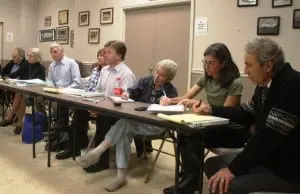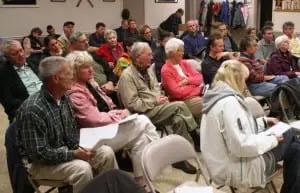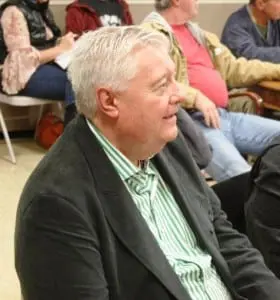
Story and photos by Michael Turton
The formal public hearing to review the draft Comprehensive Plan for Cold Spring got underway on Oct. 14 when more than 50 residents gathered at the firehouse on Main and Church Streets to comment on the document. The hearing is the culmination of more than four years of work by the Special Board responsible for recommending a new plan to the Village Board.
One of the challenges the Special Board has faced has been in piecing together the work of many volunteers into one coherent plan. Most communities rely on consultants to write their comprehensive plans; however Cold Spring opted to use volunteers – in part to save a considerable amount of money and perhaps also to ensure more community involvement. Janet Rust may have happened upon one of the flaws in that approach. She asked Special Board Chair Mike Armstrong if the plan’s narrative had been written by one person. Armstrong replied that the writing “was the the work of many.” Rust said that in some sections such as the chapter dealing with preserving Cold Spring’s historic character the plan shifts from what is a very firm tone initially to much less assertive language later on. Rust’s comments were echoed by others at the hearing who called for greater consistency throughout the plan.
While there has been unanimous agreement that preserving Cold Spring’s historic character is a vital goal there are still questions as to how that should be accomplished. Stacey Matson-Zuvic said she feels the section of the plan dealing with possible expansion of historic district “is still a little weak” and pointed out that there has been considerable public opposition to that idea. She also called for improved training opportunities for members of the Historic District Review Board and a streamlining of that body’s approval process.

Cold Spring has its share of noteworthy figures in its past and Richard Turner thinks they should be recognized as part of the plan’s goal to preserve village character. He identified Robert Parrott, inventor of the Parrott cannon; and G. Kemble Warren as deserving more prominence. A statue at Gettysburg honors Warren for his role in that pivotal Civil war battle and Turner said he feels Cold Spring should do something similar. He also mentioned Kemble’s sister Emily, who supervised the building of the Brooklyn Bridge, as someone who should be recognized for her Cold Spring roots.
Peter Henderson worked as a volunteer on one of the working groups and agreed that the plan is not yet complete. “I think we still have a long way to go,” he said. “A comprehensive plan is essentially a land use plan”¦it’s a very powerful tool. The law is clear”¦all future zoning changes must be in accordance with the comprehensive plan, so it’s very important we get this right.” He said that the land use recommendations “are scattered throughout the draft and I’m left confused as to what exactly is being proposed. I think you should separate out the non-land use topics and move them to a separate section, to distinguish between those that have legally binding implications and those that don’t. That would bring the land use issues into focus.” Henderson said he plans on submitting detailed written comments.

Facebook, Twitter and other social media have become a global force in interactive communication. David McCarthy runs a marketing business based in Cold Spring and San Francisco. He urged the Special Board to “include a strong social media component in the marketing plan.” McCarthy pointed to Breakneck Ridge, identified as the most popular day hike in the country, as an “incredible opportunity” for promoting local businesses and suggested that the Cold Spring trolley be rerouted to serve hikers who go there. By village use of social media, McCarthy said that hikers and other visitors can become a key part of Cold Spring’s marketing efforts. “And it’s free!” he said.
The village garage continues to garner considerable attention. A large majority of those who have commented on the facility have supported a change that would see the property used for open space or visitor-oriented commercial enterprises that take advantage of the panoramic views of the Hudson River and the Highlands. However at least one resident at the hearing disagreed, saying that he felt it should remain a truck yard because of its central location and amount of money that the village has spent on developing it for that purpose.
To meter or not to meter is still a question in the minds of many residents. Main Street parking meters have been hailed as a potential source of up to $180,000 in annual revenue for the village but Cecile Linstadt sees it it very differently and thinks they should not be part of the plan. “I’m very much against parking meters,” she said. “They go against everything that the village is about. It upsets me very much.”
Tom Rolston, owner of The Depot Restaurant spoke in support the draft plan. “I like it. It’s a way for the village to save money and to make money. It’s vague enough to allow interpretation. I’m not saying there isn’t more work to do on it – but it’s a good plan,” he said. Rolston, who worked on the initial survey of village residents and was also involved with studying the parking issue, disagreed with those at the hearing who oppose parking meters and moving the village truck yard. “Our taxes are the 12th highest in the country. We have tourists coming here – we might as well make some money,” he said.

Almost everyone who spoke at the hearing began by thanking the members of the Special Board for their efforts. But not quite everyone. Lilian Moser was the first member of the audience to speak and introduced herself as “proud member of the Cold Spring Fire Company.” Her positive remarks ended there. Moser said that she had served on the Special Board as its Vice Chair, “Until I was forced to resign”¦. My biggest problem is that after four years of work the (plan’s) 89 pages do not show the work that was done.” She said that too much information gathered regarding emergency services had been excluded. She also said that the plan contains a “big mistake” in that it refers to the Philipstown Volunteer Ambulance Corps as the Putnam Valley Volunteer Ambulance Corps. In a voice that shook with anger Moser concluded saying,” I am ashamed to see what has come out of this. I am really glad I am not part of it.”
Phyllis and Seymour Postilnik came to the hearing expecting it to be a discussion of the Local Waterfront Revitalization Plan (LWRP) and seemed reluctant to accept that the meeting was intended to deal only with the Comprehensive Plan. The LWRP is similar to but more detailed than the Comprehensive Plan. The Special Board is also responsible for creating the LWRP and had begun work on it only to set the project aside due to a postponement in New York State funding. Instead they devoted their attention to completing the Comprehensive Plan. The Postilnik‘s quizzed Armstrong a number of times regarding the status of the LWRP. Armstrong explained that funding for the LWRP has been reinstated and that work on that document will resume after the Comprehensive Plan is complete.
The Public Hearing on Cold Spring’s Comprehensive Plan will remain open until Thursday, Oct. 21. That evening a final meeting will be held once again at the firehouse on Main Street at 7:30 p.m. Written and verbal comments will be accepted until the close of that meeting.

The Special Board will then meet on Oct. 28 to review comments received and to discuss how the plan might be revised in light of recent public input. Once the Special Board is satisfied with its final revisions it will vote to recommend the plan to the Cold Spring Village Board. The Village Board will be free to revise the plan but is required to hold its own public hearing before adopting the Comprehensive Plan. Future Village Boards can also change the plan but only after a formal public review, including public hearings. Armstrong said that the Special Board will recommend that a review of the plan be undertaken annually and that a detailed review, possibly to include revisions, be done every five years in order to keep it up to date.
Click here to view the entire draft Comprehensive Plan.


Thanks for a good and balanced article covering the first part of the Public Hearing. We are hoping we have a good turnout for the second part, on Thursday 10/21 at 7:30 pm at the Firehouse. The Comprehensive Plan is the result of a Community-wide effort that both distills community opinion and seeks solutions to the challenges facing us. Above all, the Plan is really a process — a process of engaging and focusing the community on key decisions and issues — and a process that will last for the full 20 years of the scope of the plan, and beyond. After the Plan is recommended by the Special Board, the public will still have ample opportunity to comment, and the Village Trustees will have ample opportunity to change the Plan in any way they want. Even after it is adopted, the Plan can be changed, using Public Hearings, and in the discussion on Implementation the Special Board recommends intensive five year reviews to ensure this is still the best plan for the village. The important thing is to move forward in the spirit of enterprise that lies at the heart of what is best about this village, and this country.
Mike Armstrong